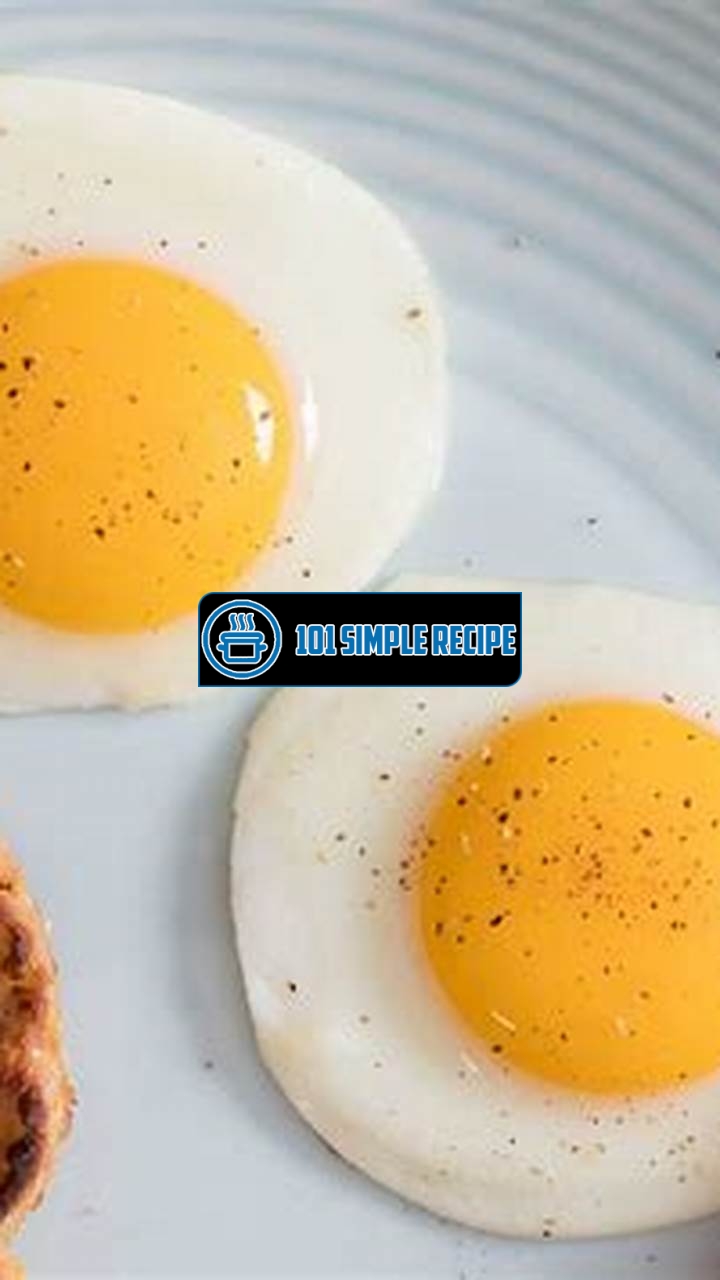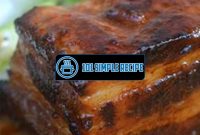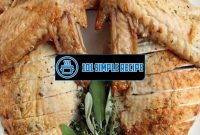Welcome to the world of culinary delights! Are you ready to master the art of cooking and impress your taste buds with a perfectly fried egg sunny side up? Whether you’re a beginner in the kitchen or a seasoned chef, this simple yet delicious dish is a staple for breakfast lovers everywhere. In this article, we will guide you through the step-by-step process of achieving that golden, runny yolk paired with a crispy edge. So grab your apron and get ready to elevate your breakfast game!

The Perfect Pan and Heat Level
When it comes to frying a sunny side up egg, using the right pan and heat level is crucial for achieving the perfect result. The pan you choose and the heat level you use can greatly impact the cooking process and the final outcome of your egg. In this section, we will explore the importance of selecting the right pan and understanding heat levels to master the art of cooking a delicious sunny side up egg.
Choosing the Right Pan
Choosing the right pan is the first step to cooking a perfect sunny side up egg. You want to select a non-stick pan with a flat surface that allows for even heat distribution. This will prevent your egg from sticking to the pan and ensure that it cooks evenly. Additionally, the size of the pan matters. Using a smaller pan will help contain the egg and prevent it from spreading out too much.
Important point: Select a non-stick pan with a flat surface for even heat distribution.
Note: Using a smaller pan will help contain the egg and prevent it from spreading out too much.
Understanding Heat Levels
Understanding heat levels is the key to perfectly frying a sunny side up egg. You should aim for medium heat when cooking your egg. Too high of a heat can cause the egg to cook too quickly and result in a rubbery texture, while too low of a heat will make the egg take longer to cook and potentially result in an undercooked yolk.
Important point: Aim for medium heat when frying your sunny side up egg.
Note: Avoid using high heat, as it can cause the egg to cook too quickly and result in a rubbery texture.
Mastering Temperature Control
Temperature control is essential for achieving the perfect sunny side up egg. Start by preheating your pan over medium heat for a couple of minutes. To check if the pan is hot enough, you can sprinkle a few drops of water onto the surface. If the water sizzles and evaporates immediately, the pan is ready for the egg.
Important point: Preheat your pan over medium heat and test the temperature using the water sprinkle method.
Note: A hot pan will help ensure the egg cooks evenly and prevent it from sticking to the surface.
By selecting the right pan, understanding heat levels, and mastering temperature control, you can elevate your sunny side up egg cooking skills to new heights. Take these tips into consideration, and with practice, you will be able to consistently fry the perfect sunny side up egg that will impress anyone who takes a bite.
Prepping the Egg
Before you fry an egg sunny side up, it’s important to properly prep the egg. This ensures that it cooks evenly and is safe to consume. Follow these key steps to prepare the egg:
Cracking the Egg
The first step in prepping the egg is cracking it. To do this, gently tap the egg on a hard surface, such as the edge of a countertop or a bowl. Aim to create a clean crack that allows you to easily separate the eggshell.
Removing Shell Fragments
After cracking the egg, it’s crucial to remove any shell fragments that may have fallen into the bowl. The presence of shell fragments can ruin the texture of your sunny side up egg. To remove them, use a clean spoon or your fingers to carefully pick out any visible pieces.
Seasoning the Egg
Seasoning the egg is an optional step but can greatly enhance the flavor of your sunny side up egg. To do this, sprinkle a small pinch of salt and pepper onto the cracked egg, according to your taste preferences. Additionally, you can experiment with other herbs and spices to add a unique twist to your dish.
In summary, to properly prep the egg before frying it sunny side up, crack the egg cleanly, remove any shell fragments, and season it to your liking. These simple yet important steps will ensure that your sunny side up egg turns out delicious and visually appealing.
Grease or No Grease: The Cooking Fat Dilemma
When it comes to frying a sunny side up egg, one of the first decisions you have to make is whether or not to use cooking fat. This has been a topic of debate among culinary enthusiasts for years, with opinions varying widely. Some argue that greasing the pan provides a richer flavor and prevents sticking, while others believe that it adds unnecessary calories. Let’s uncover the pros and cons of using cooking fat when frying a sunny side up egg.
One of the main benefits of using cooking fat is that it adds flavor to the egg. Butter, for example, can bring a rich and creamy taste, enhancing the overall experience. It also creates a golden crust on the edges of the egg, adding a delightful crunch. On the other hand, if you prefer a more neutral taste, using oil might be a better option, as it allows the natural flavor of the egg to shine through.
Another consideration is the prevention of sticking. When you add cooking fat to the pan, it forms a barrier between the egg and the surface, reducing the likelihood of the egg sticking and making it easier to flip without any mishaps. This is especially important when cooking sunny side up eggs, as the yolk is left runny, and any damage to the delicate yolk membrane can spoil the dish. However, with proper pan preparation and using a non-stick pan, you may not need to use any cooking fat at all.
It is worth noting that using cooking fat can add extra calories to your meal. If you are watching your calorie intake or following a specific diet, this might be a deciding factor for you. However, it is important to remember that the amount of cooking fat used for frying a sunny side up egg is relatively small compared to other cooking methods. Moderation is key, and it is always possible to balance out the extra calories by making healthier choices in other aspects of your diet.
Butter or Oil: Which is Better?
When it comes to choosing between butter and oil, personal preference plays a significant role. Both have their unique characteristics and can influence the flavor and texture of the egg. Butter is known for its rich and creamy taste, while oil tends to be more neutral. Some people enjoy the added richness that butter brings, while others prefer the simplicity of oil.
In terms of health considerations, it is important to note that butter is higher in saturated fats compared to most cooking oils. Saturated fats have been linked to an increased risk of heart disease, so if you are mindful of your cardiovascular health, it may be best to opt for a healthier oil option, such as olive oil or avocado oil. These oils contain healthier unsaturated fats, which can be beneficial for your heart.
Alternative Cooking Sprays
For those who want to avoid using butter or oil altogether, there are alternative cooking sprays available in the market. These sprays are designed to provide a non-stick coating to the pan, similar to cooking fat, but with fewer calories. They typically contain a blend of oils or other ingredients that help prevent sticking and make it easier to fry a sunny side up egg.
It is important to read the labels and choose a cooking spray that is suitable for high-heat cooking. Some sprays may not withstand the high temperatures required for frying an egg, which can lead to stickiness or even burnt residue on the pan. Look for sprays specifically marketed for frying or searing, and ensure they have a high smoking point to avoid any unpleasant flavors.
The Secret to a Non-Stick Pan
Whether you decide to use cooking fat or opt for a cooking spray, a non-stick pan is essential for successfully frying a sunny side up egg. A good quality non-stick pan can help you achieve the perfect texture and presentation without the need for excess cooking fat.
When choosing a non-stick pan, look for one with a durable coating that can withstand high temperatures. It should also have a flat surface and even heat distribution to ensure that the egg cooks evenly. Proper care and maintenance of the pan are crucial to preserving its non-stick properties, so avoid using metal utensils that can scratch the surface and follow the manufacturer’s instructions for cleaning and storage.
Mastering the art of frying an egg sunny side up involves finding the right balance between using cooking fat, choosing the right cooking medium, and having the proper equipment. Whether you decide to use greased or non-greased pans, butter or oil, or alternative cooking sprays, experiment with different methods to find the one that suits your taste preferences and dietary needs. With a little practice and patience, you’ll be able to serve up a perfect sunny side up egg every time.
Learn how to make kaiser rolls to serve as a side for your sunny side up eggs.
The Technique: Crispy Edges and Runny Yolk
Mastering the art of cooking sunny side up eggs requires a delicate technique that results in the perfect combination of crispy edges and a runny yolk. This popular egg preparation is beloved for its simplicity and versatility. Whether you are looking to enjoy it as a delicious breakfast or use it as a topping for salads or sandwiches, here’s how you can achieve the ideal texture:
Gentle Heat for Cooked Whites
The key to achieving the ideal texture for the whites of a sunny side up egg lies in gentle heat. Start by preheating your non-stick frying pan over medium-low heat. The low heat ensures that the whites cook slowly and evenly without browning, achieving a tender and delicate consistency. Avoid using high heat, as it can cause the whites to become tough and rubbery.
Pro tip: Keep the heat low to prevent the egg whites from turning tough and rubbery.
Keeping the Yolk Runny
The hallmark of a perfectly cooked sunny side up egg is a runny yolk that adds richness and flavor to every bite. To maintain the yolk’s desirable consistency, carefully crack the egg into the preheated pan, taking care not to break the yolk. Allow the egg to cook undisturbed until the whites are fully set, while ensuring that the yolk remains soft and runny. This typically takes around 2-3 minutes.
Pro tip: Gently slide the egg onto the pan to avoid breaking the yolk and achieve a perfect runny center.
Adding a Cover for Uniform Cooking
If you prefer your sunny side up eggs with a more evenly cooked white, consider adding a cover to the pan while cooking. This helps to trap the heat, ensuring that the top of the egg cooks more quickly without flipping it. The steam created inside the pan from the cover helps to gently cook the top part of the egg, resulting in a deliciously creamy texture throughout.
Pro tip: Place a lid on the pan for a more uniformly cooked sunny side up egg with a creamy texture.
By mastering the art of cooking sunny side up eggs, you can enjoy the perfect combination of crispy edges and a runny yolk. Remember to maintain gentle heat, keep the yolk runny, and consider adding a cover for uniform cooking. With these techniques, you’ll be able to elevate your breakfast or any dish that calls for a sunny side up egg. Happy cooking!
This recipe for cookie in a mug makes a delicious dessert to complement your sunny side up eggs.
Troubleshooting Common Mistakes
When it comes to frying a sunny side up egg, there are a few common challenges that home cooks often face. However, with the right techniques and a little practice, you can easily overcome these obstacles and master the art of cooking the perfect sunny side up egg. In this article, we will cover some of the most common mistakes and provide you with practical tips to troubleshoot them.
Preventing Overcooking
One of the most common mistakes when frying an egg sunny side up is overcooking it. This can result in a rubbery texture and an unpleasant taste. To prevent overcooking, it’s important to pay attention to the cooking time.
⭐ Tip: As soon as the egg white is set and the edges start to turn golden brown, it’s time to remove the egg from the heat. The residual heat will continue to cook the egg, resulting in a perfectly cooked sunny side up egg with a runny yolk.
Dealing with Broken Yolks
Another common challenge when frying a sunny side up egg is dealing with broken yolks. There’s nothing more frustrating than a broken yolk ruining the presentation of your egg. However, there are a few tricks you can use to minimize the risk of yolks breaking.
⭐ Tip: First, make sure to crack the egg gently into a small bowl or ramekin before transferring it to the pan. This will help you avoid accidentally breaking the yolk while cracking the egg directly into the pan. Additionally, using fresh eggs can also reduce the chances of yolks breaking as older eggs tend to have weaker yolks.
Solving Sticking to the Pan Issues
Sticking to the pan is another frustrating problem that can occur when frying a sunny side up egg. This can make it difficult to remove the egg from the pan without breaking it. To avoid sticking issues, follow these simple steps:
- ⭐ Tip: Preheat the pan properly before adding the oil or butter. This will create a non-stick surface and prevent the egg from sticking to the pan.
- ⭐ Tip: Use a non-stick pan or a well-seasoned cast iron skillet. These types of pans are less likely to cause sticking issues compared to regular stainless steel pans.
- ⭐ Tip: Add enough oil or butter to the pan to create a thin layer. This will further reduce the chances of the egg sticking to the pan.
By following these troubleshooting tips, you can overcome the common mistakes that many home cooks face when frying a sunny side up egg. Remember to keep practicing and experimenting with different techniques to find the perfect method that suits your preferences. With time and patience, you’ll become a master of cooking the perfect sunny side up egg every time!
Here is a recipe for garlic bread sticks that you can enjoy with your sunny side up eggs.
Thank you for taking the time to read our article on how to fry an egg sunny side up. We hope you found it informative and helpful in achieving the perfect sunny side up egg. Whether you’re a beginner in the kitchen or an experienced cook, knowing the right techniques can make all the difference. Don’t hesitate to visit our website again for more cooking tips and recipes. Happy cooking!
Frequently Asked Questions
Here are some commonly asked questions about frying an egg sunny side up:
| No. | Questions | Answers |
|---|---|---|
| 1. | What is the best type of pan to use? | A non-stick pan is ideal for frying eggs sunny side up. It prevents the eggs from sticking and makes flipping easier. However, if you don’t have a non-stick pan, you can use a well-seasoned cast iron skillet. |
| 2. | Should I use butter or oil? | Butter adds a richer flavor to the eggs, but it can burn at high heat. Oil, on the other hand, has a higher smoke point and is a safer option for high-heat cooking. It ultimately depends on your preference. |
| 3. | How do I know when the egg is cooked? | The whites should be fully set, but the yolk should still be runny. To check the doneness, gently touch the whites with a fork or spatula. If they feel soft and slightly firm, the egg is ready. |
| 4. | Can I season the egg while it’s cooking? | Yes, you can sprinkle salt, pepper, or any other desired seasonings on the egg while it’s cooking. However, if you want to keep the yolk intact, it’s best to season it after it’s cooked. |
| 5. | Should I cover the pan while frying the egg? | Covering the pan helps to cook the egg more evenly and avoid a runny yolk. If you prefer a completely set yolk, you can cover the pan for the last minute or two of cooking. |
| 6. | Can I add toppings to my sunny side up egg? | Absolutely! You can get creative with toppings like grated cheese, herbs, or even salsa to enhance the flavor of your sunny side up egg. Just add them right after you flip the egg. |
Closing Thoughts
We hope this article has given you the knowledge and confidence to fry the perfect sunny side up egg. Remember, practice makes perfect, so don’t be discouraged if you don’t get it right the first time. With the right techniques and a little patience, you’ll soon be enjoying a beautifully cooked sunny side up egg. Thank you for reading and we look forward to seeing you back here soon for more cooking inspiration!
Jump to Recipe
How to Fry an Egg Sunny Side Up

Learn how to fry an egg sunny side up with our easy-to-follow guide. Perfect for breakfast or brunch, sunny side up eggs are delicious and versatile. Follow our step-by-step instructions to achieve the perfect runny yolk and cooked whites.
- 1 large egg
- 1 tablespoon butter or oil
- Salt and pepper (to taste)
- Place a non-stick pan over medium heat and let it warm up.
- Once the pan is hot, add the butter or oil and let it melt or heat up.
- Carefully crack the egg and gently slide it into the pan, making sure not to break the yolk.
- Sprinkle salt and pepper over the egg, if desired.
- Let the egg cook undisturbed for about 3-4 minutes, or until the whites are fully set and the yolk is still runny.
- If desired, carefully flip the egg using a spatula and cook for an additional 30 seconds to 1 minute for a slightly firmer yolk. Alternatively, cover the pan for the last minute or two of cooking for a fully set yolk.
- Carefully remove the egg from the pan and transfer it to a plate. Serve immediately and enjoy!






